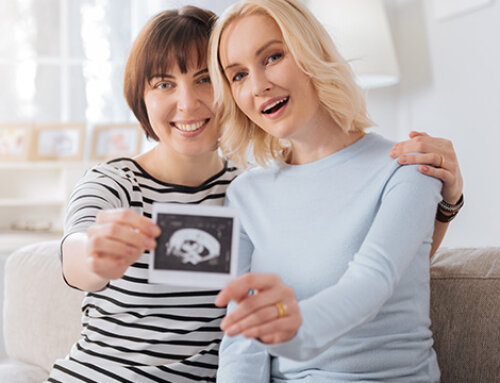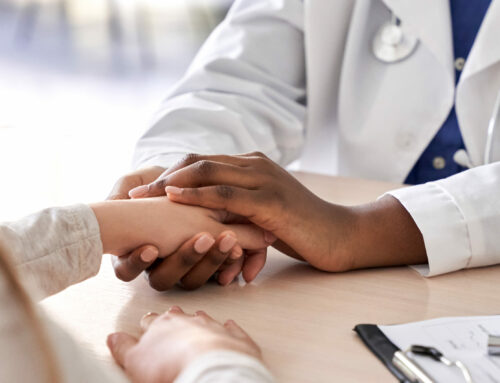Living with endometriosis can be an uncomfortable experience. From severe cramps to heavy cycles, this medical condition is an easy one to overlook and brush off as a “bad period”, but should you be looking at it more carefully? Read below to see common endometriosis causes and symptoms, the tie between endometriosis and fertility, and what you can do to ensure you are as healthy as possible.
What is Endometriosis?
Endometriosis is a health condition affecting the pelvic organs in which the endometrium tissue, or the tissue lining the uterus, grows outside of the uterus. The most commonly affected organs are the ovaries, fallopian tubes, and pelvic tissue lining. When the uterine lining exists outside of the uterus, it continues to exhibit the same characteristics of a healthy lining – thickening, breaking down, and bleeding every menstrual cycle.
This process becomes toxic with endometriosis as the tissue cannot be expelled from the body. As the misplaced uterine lining builds up, it becomes harmful and can cause irritation in the surrounding tissue. The resulting scar tissue from said irritation enables pelvic organs and tissues to stick together, causing extreme discomfort.
Endometriosis Causes and Symptoms
Causes of Endometriosis
- Embryonic Cell Transformation: During puberty, hormones impact embryonic cells during the earlier phases of development, transforming them into endometrial cell implants.
- Endometrial Cell Transport: Endometrial cells are transported to other parts of the body through the blood vessels or tissue fluid of the lymphatic system.
- Immune System Disorder: A weakened immune system fails to recognize and destroy harmful endometrial tissue present outside the uterus.
- Peritoneal Cell Transformation: Hormones or immune factors transform peritoneal cells that line the inner abdomen into endometrial cells.
- Surgical Scarring: Incisions from pelvic-area surgeries allow endometrial cells to attach and grow outside of the uterus.
- Retrograde Menstruation: Endometrial cells flow into the pelvic cavity in menstrual blood carried through the fallopian tubes, allowing cells to attach and grow on pelvic walls and organs.
In addition to these potential endometriosis causes, risk factors that can increase your chances of facing endometriosis include alcohol consumption, a low BMI, family history, short menstrual cycles, high levels of estrogen, never giving birth, and having other uterine disorders.
 Symptoms of Endometriosis
Symptoms of Endometriosis
- Abdominal Pain
- Bleeding Between Periods (Menometrorrhagia)
- Bloating
- Constipation
- Diarrhea
- Heavy Periods (Menorrhagia)
- Infertility
- Lower Back Pain
- Nausea
- Pain During Intercourse
- Pain During Bowel Movements or Urination
- Painful Periods (Dysmenorrhea)
The Tie Between Endometriosis and Infertility
One of the biggest myths surrounding endometriosis and infertility is that the condition causes infertility. While the disorder can contribute to infertility, it is not a direct cause. One-third to one-half of women with the disorder have more difficulty conceiving a child. Many times, endometriosis is first diagnosed when women seek fertility treatments.
Abnormalities in the uterine lining can cause obstructions in the reproductive organs. Obstructed ovaries may prevent eggs from being released. Obstructions in the fallopian tubes create difficulty for eggs and sperm to successfully move through the process and unite for fertilization, or for the fertilized egg to reach the uterus. The scarring from endometriosis reduces your egg’s chances of fertilization, and the pelvic toxins make for an unfit environment for the egg’s survival. Additionally, the condition may cause indirect infertility by damaging the eggs and sperm themselves.
Thankfully, 60-70% of women with endometriosis are fertile, and approximately one third of women with endometriosis will conceive naturally! On top of that, about half of those who are fertile with endometriosis and seek treatment for infertility are eventually able to conceive.
 Endometriosis and Fertility Treatments
Endometriosis and Fertility Treatments
An abnormal immune system, along with obstructions and toxins preventing fertilization, make it difficult for traditional fertility treatments to take hold. However, assisted reproductive technology (ART) such as in-vitro fertilization (IVF) has proven to be one of the most effective solutions for endometriosis and fertility treatments.
Recent studies from the The University of Tokyo Graduate School of Medicine, Department of Obstetrics and Gynecology, show that those with advanced endometriosis who used ART experienced a higher rate of conception than those who used non-ART methods such as intrauterine insemination (IUI) or timed intercourse. According to the studies, 49% of women treated with ART gave birth within 18 months of treatment, as opposed to the 22% of women using non-ART methods.
Do I Have Endometriosis?
If you suspect endometriosis may be affecting your chances of conceiving, book an appointment at Red Rock Fertility Center. At Red Rock Fertility, Dr. Littman will provide a complete fertility evaluation and will review your complete medical history. If endometriosis is suspected, she may perform an ultrasound to identify any growths. If we are unable to detect something on-screen, laparoscopic surgery may be used to confirm the condition.
Depending on the severity of the endometriosis, Dr. Littman may try to remove the toxic tissue, eliminating the obstacles to conception. If blocking is too prevalent or the pelvic organs are too damaged, scheduling an appointment for IVF may offer the best chances of success toward growing your family.



